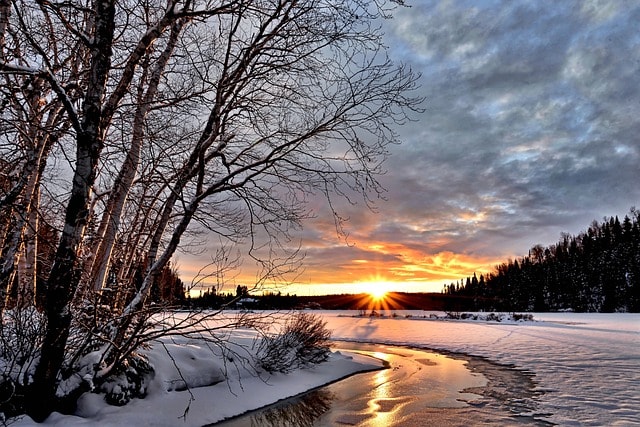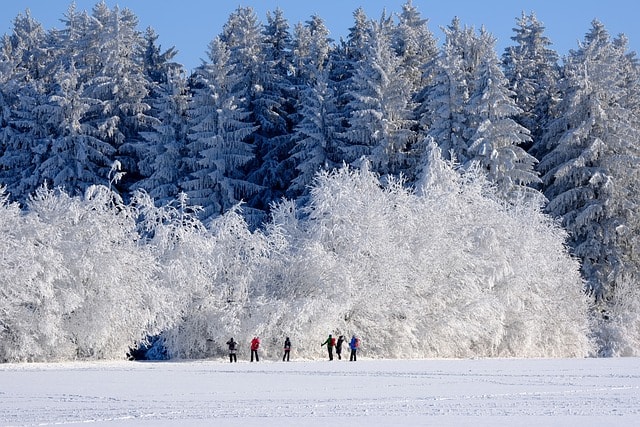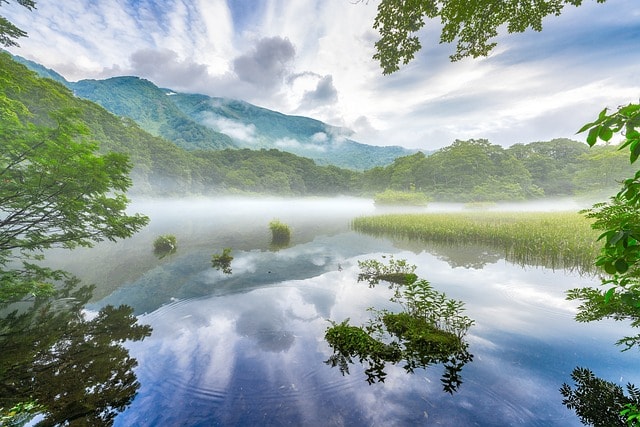Ireland generally experiences mild temperatures, but it can get warm during the summer months. In summer, from June to August, average daytime temperatures typically range from 15°C to 20°C (59°F to 68°F). However, during occasional warm spells, temperatures can rise to the mid-20s Celsius (mid-70s Fahrenheit) and sometimes even higher. The highest temperature ever recorded in Ireland was 33.3°C (91.9°F) in Kilkenny in June 1887.
Coastal areas, influenced by the Atlantic Ocean, tend to be cooler, while inland regions can experience slightly higher temperatures. The southeastern and southern parts of Ireland, including counties like Wexford, Waterford, and Cork, are usually the warmest.
During winter, temperatures are much milder compared to many other countries, with average daytime temperatures ranging from 5°C to 8°C (41°F to 46°F). Nighttime temperatures can drop to around 0°C to 4°C (32°F to 39°F), and frost is common, especially in inland areas.
Overall, while Ireland does not experience extreme heat, the occasional warm summer days provide pleasant conditions for outdoor activities and exploration.

How Hot Does Ireland Get in Summer?
Ireland's summer months, from June to August, are characterized by mild to warm temperatures, which can vary significantly across the seasons and different regions. While Ireland is not known for extreme heat, there are occasional warm spells and rain that can make temperatures quite pleasant.
Average Summer Temperatures
During the summer, average daytime temperatures in Ireland typically range from 15°C to 20°C (59°F to 68°F). However, temperatures can occasionally rise above this range during warm spells. Coastal areas tend to be cooler due to the influence of the Atlantic Ocean, while inland areas can experience slightly higher temperatures.
Warm Spells
Ireland does experience occasional warm spells during the summer months. During these periods, temperatures can rise to the mid-20s Celsius (mid-70s Fahrenheit) and sometimes even higher. The highest recorded temperature in Ireland was 33.3°C (91.9°F) in Kilkenny in June 1887. More recently, temperatures in the high 20s Celsius (80s Fahrenheit) have been recorded during particularly warm summers.
Influence of Climate Change
In recent years, climate change has led to more frequent and intense heatwaves in various parts of the world, including Ireland. While extreme heat is still relatively rare in Ireland, the trend suggests that summer temperatures could become warmer and more unpredictable in the future.

How Hot Does Ireland Get in Winter?
Ireland's winter season, from December to February, is characterized by cool and damp conditions. Unlike the hot temperatures, wind and storms seen in some other parts of the world, Ireland's winters are generally mild, but can still pose challenges for residents and visitors.
Average Winter Temperatures
During the winter and spring months, average daytime temperatures in Ireland typically range from 5°C to 8°C (41°F to 46°F). Nighttime temperatures can drop further, often reaching around 0°C to 4°C (32°F to 39°F). Frost is common in colder,, particularly in inland snow over areas and during clear nights.
Cold Spells
Ireland occasionally experiences cold spells, during which temperatures can drop below freezing. These cold snaps can lead to icy conditions and frost. The lowest temperature ever recorded in Ireland was -19.1°C (-2.4°F) in Castlederg, County Tyrone, in January 1881. Such extreme cold is rare, but temperatures below freezing are not uncommon during the coldest of winter.
Influence of Climate Change
Climate change impacts Ireland's winter temperatures. Overall temperatures are rising, but periods of cold weather still occur. Additionally, climate change leads to more unpredictable weather patterns, causing fluctuations in temperature extremes, between mild and cold conditions.
Where is the Warmest and Driest Place in Ireland?
The warmest and driest place in Ireland is the southeast region, particularly around counties Wexford and Waterford. This area benefits from the prevailing southwesterly winds and the influence of the Gulf Stream, which help to create milder and drier weather conditions compared to the rest of the country. With relatively low rainfall and higher temperatures, the southeast is favored by those seeking a more temperate climate in Ireland.
Warmest Places
The warmest areas in Ireland are typically found in the southeast and southern parts of the country. Counties like Wexford, Waterford, and Cork often experience higher temperatures compared to other regions. These areas benefit from their geographic location, which shelters them from the cooler Atlantic winds.
-
Wexford: Known for its sunny weather, Wexford often enjoys warmer temperatures during the summer months. The county's coastal location and relatively low elevation contribute to its mild climate.
-
Waterford: Waterford, particularly the city and its surrounding areas, is known for having some of the warmest temperatures in Ireland. Its position on the southeast coast helps it receive more sunshine and less rainfall.
-
Cork: Cork, especially the city and southern parts of the county, also experiences warmer temperatures. The region's maritime climate ensures mild winters and relatively warm summers.
Driest Places
The driest areas in Ireland are generally found in the eastern part of the country. Counties such as Dublin, Kildare, and Meath receive less rainfall compared to the western regions, which are more exposed to the Atlantic weather systems.
-
Dublin: As the capital city, Dublin benefits from its location on the east coast, which tends to be drier than the west. The city receives less annual rainfall, making it one of the drier places in Ireland.
-
Kildare: Located just west of Dublin, Kildare also experiences relatively low rainfall. The county's central location helps shield it from the heavy rain often seen in western Ireland.
-
Meath: Similar to Kildare, Meath is another county that enjoys drier conditions. Its position in the eastern part of the country means it receives less precipitation compared to the west.

What are the Factors Behind How Hot Does Ireland Get?
Several factors influence the temperatures experienced in Ireland, from geographical location to climatic patterns and sea front. Understanding these factors can provide insights into why certain areas are either warmer weather or cooler and why temperatures fluctuate.
Geographical Location
Ireland's position in the North Atlantic Ocean significantly influences its climate. The country is situated at a latitude that experiences temperate conditions, with mild winters and cool summers. Its location at sea also means it is exposed to Atlantic weather systems, which can bring varying temperatures and precipitation.
Ocean Currents
The North Atlantic Drift, an extension of the Gulf Stream, plays a crucial role in moderating Ireland's climate. This warm ocean current flows northwards, bringing warmer waters to the north, east wind south and western coasts of Ireland. As a result, coastal areas tend to have milder winters and cooler summers compared to inland regions.
Wind Patterns
Prevailing wind patterns also affect Ireland's temperatures and seasons. The dominant southwesterly winds bring moist and mild air from the Atlantic Ocean, contributing to the overall temperate climate of ireland. During summer, these winds can moderate temperatures, while in winter, they help prevent extreme cold.
Elevation and Topography
Elevation and topography can lead to temperature variations within Ireland. Higher elevations, such as the Wicklow Mountains and other upland areas, tend to be cooler than low-lying regions. Valleys and sheltered areas can experience warmer temperatures due to reduced wind exposure.
Climate Change
Climate change is a significant factor influencing temperatures worldwide, including in Ireland. Rising global temperatures can lead to more frequent and intense heatwaves, as well as changes in seasonal weather patterns. Understanding the impact of climate change on Ireland's temperatures is crucial for adapting to future climatic conditions.
Tips To Stay Cool in Ireland During the Hot Season
While Ireland's hot season may not be as extreme as in other countries, it is still important to stay cool and comfortable during the warmest weather periods. Here are some tips to help you stay cool in Ireland during the hot season:
Stay Hydrated
Drinking plenty of water is essential to stay hydrated during warm weather. Carry a reusable water bottle with you and drink regularly to prevent dehydration.
Wear Light and Breathable Clothing
Choose light, breathable clothing made from natural fibers like cotton or linen. These materials help keep you cool by allowing air to circulate and wick away moisture.
Use Sun Protection
Protect yourself from the sun's harmful rays by wearing sunscreen with a high SPF, a wide-brimmed hat, and sunglasses. Seek shade during the peak sun hours, typically between daylight hours of 11 a.m. and 3 p.m.
Keep Indoor Spaces Cool
Keep your home cool by closing curtains or blinds during the hottest part of the day to block out direct sunlight. Use fans or air conditioning if available to maintain a comfortable indoor air temperature.
Plan Outdoor Activities Wisely
If you plan to spend time outdoors, schedule activities for the early morning or late afternoon when temperatures are cooler. Avoid strenuous activities during the hottest part of the day.
Stay Informed
Stay informed about weather forecasts and heat advisories. Knowing when to expect warmer temperatures can help you plan and prepare accordingly.

What to Pack for Ireland During the Hot Season?
Packing for Ireland during the hot season requires careful consideration to ensure comfort and preparedness for varying weather conditions. Here are some essential items to include in your packing list:
Lightweight Clothing
Pack lightweight, breathable clothing made from natural fabrics such as cotton or linen. T-shirts, shorts, and light dresses are ideal for staying cool.
Layers
Despite the warm season, temperatures can still fluctuate, especially in the evenings. Pack lightweight layers such as cardigans or light jackets that can be easily added or removed.
Sun Protection
Include sunscreen with a high SPF, sunglasses, and a wide-brimmed hat to protect yourself from the sun. A reusable water bottle is also essential to stay hydrated.
Comfortable Footwear
Pack comfortable footwear suitable for walking and exploring. Sandals or breathable sneakers are ideal for warm weather.
Rain Gear
Ireland's weather can be unpredictable, even during the hot season. Pack a lightweight, waterproof jacket or poncho and an umbrella to be prepared for sudden showers or storms.
Travel Essentials
Don’t forget travel essentials such as your passport, travel insurance, and any necessary medications. A small first aid kit can also be handy for minor injuries or illnesses.
FAQs About How Hot Does Ireland Get
How hot does Ireland get in the summer?
Ireland typically experiences mild to warm temperatures during the summer, with average daytime temperatures ranging from 15°C to 20°C (59°F to 68°F). However, temperatures can occasionally rise to the mid-20s Celsius (mid-70s Fahrenheit) during warm spells.
What is the hottest temperature ever recorded in Ireland?
The highest recorded temperature in Ireland was 33.3°C (91.9°F) in Kilkenny in June 1887. More recently, temperatures in the high 20s Celsius (80s Fahrenheit) have been recorded during particularly warm summers.
Where is the warmest place in Ireland?
The warmest areas in Ireland during spring are typically found in the south, southeast and southern parts of the country, including counties like Wexford, Waterford, and Cork. These areas benefit from their geographic location, which shelters them from the cooler Atlantic winds.
Does Ireland experience heatwaves?
While heatwaves are relatively rare in Ireland, the country does experience occasional warm spells during the summer months, where temperatures can rise above the average range.
How can I stay cool during Ireland's hot season?
To stay cool during Ireland's hot season, drink plenty of water, wear light and breathable clothing, use sun protection, keep indoor spaces cool, plan outdoor activities wisely, and stay informed about weather forecasts.
